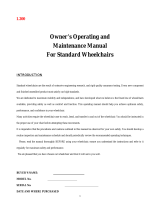
TABLE OF CONTENTS
Part No. 1148116 3 Veranda
™
TABLE OF CONTENTS
SPECIAL NOTES ................................................................................ 5
LABEL LOCATION ............................................................................ 6
TYPICAL PRODUCT PARAMETERS .................................................... 7
SECTION 1—GENERAL GUIDELINES ................................................... 8
Operating Information...............................................................................................................................8
Weight Training ..........................................................................................................................................9
Weight Limitation.......................................................................................................................................9
SECTION 2—SAFETY/HANDLING OF WHEELCHAIRS ......................... 10
Safety/Handling of Wheelchairs.............................................................................................................10
Stability and Balance.................................................................................................................................10
Reaching, Leaning and Bending Forward ........................................................................................11
Reaching, Leaning Backwards............................................................................................................11
Coping With Everyday Obstacles.........................................................................................................12
A Note to Wheelchair Assistants ........................................................................................................12
Tipping.........................................................................................................................................................12
Tipping - Curbs.....................................................................................................................................12
Stairways.....................................................................................................................................................13
Escalators....................................................................................................................................................14
Transferring To and From Other Seats ..............................................................................................14
Unfolding and Folding Wheelchair .......................................................................................................15
Unfolding................................................................................................................................................15
Folding Wheelchair..............................................................................................................................16
SECTION 3—SAFETY INSPECTION/TROUBLESHOOTING .................... 17
Safety Inspection Checklist.....................................................................................................................17
Inspect/Adjust Initially ...................................................................................................................17
Inspect/Adjust Weekly ..................................................................................................................18
Inspect/Adjust Monthly .................................................................................................................18
Inspect/Adjust Periodically ...........................................................................................................18
Troubleshooting........................................................................................................................................19
Maintenance Safety Precautions............................................................................................................19
SECTION 4—FRONT RIGGINGS ........................................................ 21
Installing/Removing Front Riggings .......................................................................................................21
Installing..................................................................................................................................................21
Removing ...............................................................................................................................................21
Adjusting Footrest Height ......................................................................................................................22
Raising/Lowering Elevating Legrest Assembly....................................................................................22






















